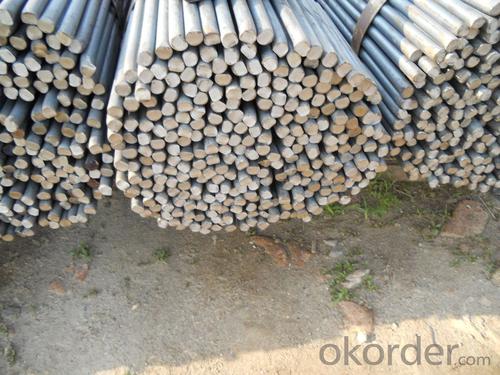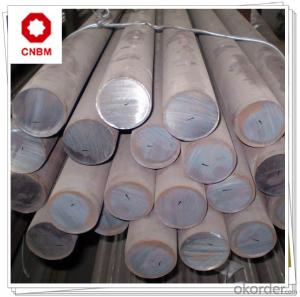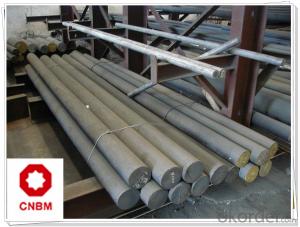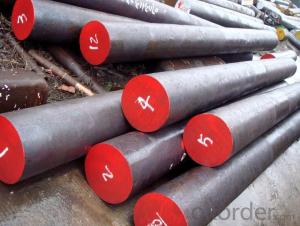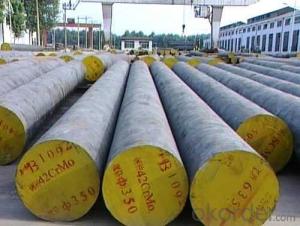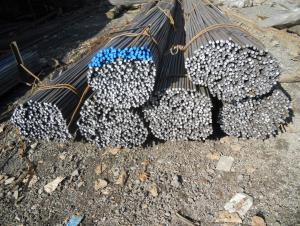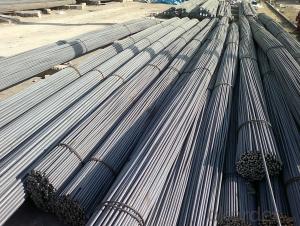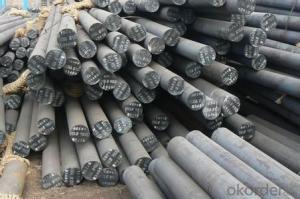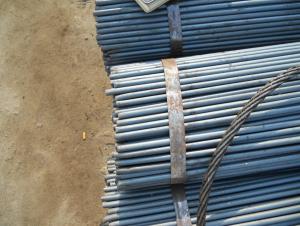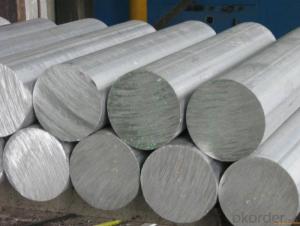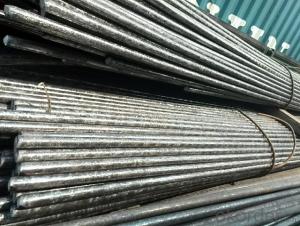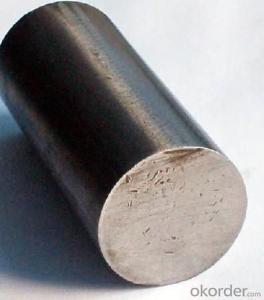alloy round steel bar JIS /GB/DIN STANDAR
- Loading Port:
- Shanghai
- Payment Terms:
- TT OR LC
- Min Order Qty:
- 100 m.t.
- Supply Capability:
- 100000 m.t./month
OKorder Service Pledge
OKorder Financial Service
You Might Also Like
Product Description:
Specifications of Hot Rolled Round Bar
1. Grade: Q235, SS400, A36, S235JR
2. Diameter: 6mm—150mm
3. Length: As customer’s request, but we usually produce 6m, 9m and 12m
4. Steel Grade: Mild carbon steel
5. Characteristics: Has a good harden ability, high hardness, wear resistance, heat distortion, etc. So it can be used in the production of heavy duty and complex shape mold.
6. Main Markets: Mid East, Southeast Asia, Africa, Oceania, Eastern Asia, Central America and South America, etc.
Usage and Applications of Hot Rolled Round Bar
1. Hot rolled round bar of 6-25mm, or small round is mostly used for straight bundles supply, and used for steel, bolts and various mechanical parts. While the bigger round bar, or more than 25mm hot rolled bar, is mainly for the manufacture of mechanical parts or for seamless steel billet.
2. Besides, we can supply some especial material steel round bar that can be used for main shaft of steamer, hummer shank, with big section and supper force.
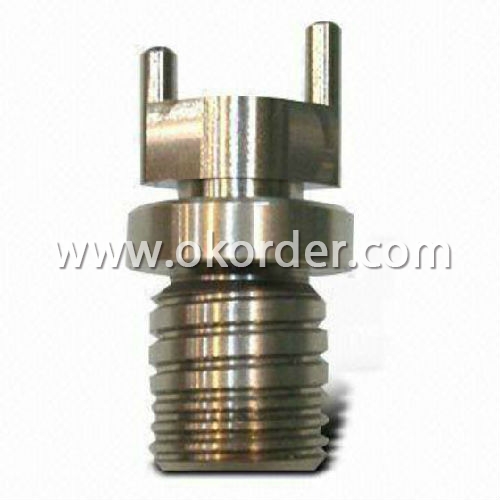
Packaging & Delivery of Hot Rolled Round Bar
Packaging Detail: All goods are packed in bundle with steel strips and shipped by break bulk vessel or container (depend on target market and different ports)
Delivery Detail: 45 days
Trade terms: FOB, CFR, CIF
MOQ: 25 tons per specification; we can negotiate the quantity if the specification is normal or we have stock of one specification.
Weight: The price invoicing on theoretical weight basis or actual weight basis depends on customer’s request.
Shipment: The shipment of bulk break or container is depends on customer’s request and the situation of the port of destination.
Documents given: Full set of original clean on board bill of lading; Original signed commercial invoice; Original packing list; Policy of insurance; Certificate of origin and what the target market needs.
Production Flow of Hot Rolled Round Bar
We use advanced equipments like Electric Arc Furnace, Ladle Furnace and Vacuum Degasser to produce our products.
The common processes are preheated forging quenching, dual refinement solution process, cooling quenching and isothermal quenching. We use heat treatment for dual refinement solution process. The main measures process is high temperature solution and refinement cycle. High temperature solution can improve the carbide morphology and particle size. The aim is to make the loop refinement ultrafine austenite grains.
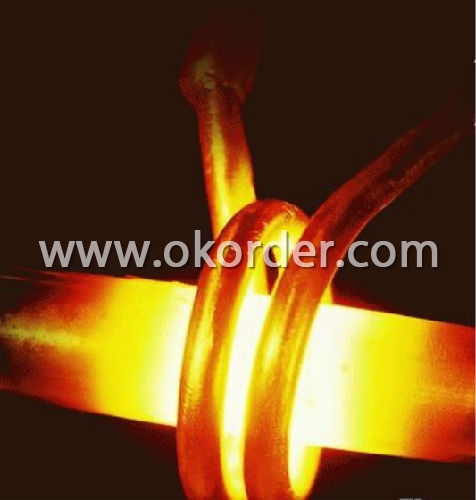
Quality Assurance of Hot Rolled Round Bar
1. We will strictly inspect our production that we sold according to the customer’s request.
2. Quality should be in conformity with the specification of the manufacturer. Quantity and packing conditions should be in conformity with the term in the contract.
3. Should the packing found damaged, the buyer has the right to claim to the seller.
- Q: What are the advantages of using mild steel round bars?
- There are several advantages of using mild steel round bars in various applications. Firstly, mild steel round bars have excellent strength and durability. They are able to withstand high amounts of stress and pressure, making them suitable for use in construction, manufacturing, and engineering projects. The strength of mild steel round bars ensures that they do not easily deform or break under heavy loads, providing a reliable and long-lasting solution. Secondly, mild steel round bars have good weldability. They can be easily joined or attached to other materials through welding, making them versatile in different applications. This allows for easy customization and flexibility in design, as the bars can be shaped and connected to create complex structures or components. Additionally, mild steel round bars have a low carbon content, making them more cost-effective compared to other types of steel. They are readily available and affordable, making them a popular choice in various industries. Moreover, mild steel round bars have good machinability. They can be easily cut, drilled, and shaped using common machining techniques, allowing for easy fabrication and customization. This makes them suitable for a wide range of applications, from construction to automotive components. Lastly, mild steel round bars have good corrosion resistance. While they may not be as corrosion-resistant as stainless steel, they still offer adequate protection against rust and other forms of corrosion. This makes them suitable for outdoor applications or environments with high humidity or exposure to moisture. In summary, the advantages of using mild steel round bars include their excellent strength and durability, good weldability, cost-effectiveness, machinability, and corrosion resistance. These factors make them a reliable and versatile choice for various industrial and construction applications.
- Q: Can steel round bars be used for making stabilizer bars?
- Yes, steel round bars can be used for making stabilizer bars. Steel round bars are commonly used in various industries, including automotive, for their high strength and durability. Stabilizer bars require materials that can withstand heavy loads and provide stability, making steel round bars an ideal choice for their construction.
- Q: What is the elongation of a steel round bar?
- The elongation of a steel round bar refers to the amount of lengthening or stretching the bar undergoes when subjected to an applied force or load.
- Q: Can steel round bars be used for making transmission towers?
- Yes, steel round bars can be used for making transmission towers. Steel round bars are strong, durable, and have excellent load-bearing capabilities, making them suitable for supporting the weight and structure of transmission towers.
- Q: Can steel round bars be extruded?
- No, steel round bars cannot be extruded. Extrusion is a manufacturing process that involves forcing material through a die to create a specific shape or profile. While steel can be extruded into various shapes, such as tubes, channels, or angles, round bars are typically not produced by extrusion. Instead, steel round bars are usually made through a different process called hot rolling, where a cylindrical billet is heated and passed through a series of rollers to achieve the desired diameter and length.
- Q: Can steel round bars be used for making furniture?
- Yes, steel round bars can be used for making furniture. Steel is a durable and sturdy material, which makes it suitable for creating various types of furniture such as tables, chairs, and shelves. The round bars can be shaped and welded to fit the desired design, providing a modern and industrial look to the furniture.
- Q: Which is hard, round steel or screw steel?
- Round bar is divided into three parts: hot rolling, forging and cold drawing. Standard Specification for hot rolled round steel is 5.5-250 mm. Of them: 5.5-25 mm small round bars are mostly supplied by straight strips. They are used as reinforcing bars, bolts and various mechanical parts. They are more than 25 millimeters of round steel. They are mainly used in the manufacture of mechanical parts or seamless steel tube billets
- Q: What are the different surface coatings available for steel round bars?
- There are several different surface coatings available for steel round bars, including galvanized coatings, epoxy coatings, powder coatings, and chrome coatings.
- Q: What are steel round bars?
- Steel round bars are long, cylindrical metal bars that are made from steel. They are commonly used in various industries such as construction, manufacturing, and engineering. These bars are known for their strength, durability, and versatility. Steel round bars are typically produced through a hot rolling process, where a solid steel billet is heated and passed through a series of rollers to achieve the desired shape and size. They come in a range of sizes and grades, with different properties depending on the specific application. These bars are often used as structural components in buildings, as shafts in machinery, as support bars in concrete structures, and as raw material for the production of other steel products. Due to their high tensile strength and resistance to corrosion, steel round bars are widely preferred in the construction and manufacturing sectors.
- Q: What are the specifications and standards for steel round bars?
- The specifications and standards for steel round bars vary depending on the intended use and industry requirements. However, there are some general specifications and standards that apply to most steel round bars. Firstly, the dimensions of steel round bars are typically specified in terms of diameter, length, and tolerance levels. The diameter can range from a few millimeters to several inches, and the length can vary as per the customer's needs. The tolerance levels indicate the allowable deviation from the specified dimensions and ensure the bars meet the desired accuracy and consistency. In terms of material composition, steel round bars are predominantly made from carbon steel, alloy steel, or stainless steel. The specific grade and composition of the steel will depend on the application, such as structural, construction, automotive, or aerospace. These grades are established by various organizations, such as the American Society for Testing and Materials (ASTM) or the International Organization for Standardization (ISO), and they define the chemical composition, mechanical properties, and other characteristics of the steel. Regarding mechanical properties, steel round bars must meet certain standards to ensure their strength, ductility, and resilience. These properties include tensile strength, yield strength, elongation, hardness, impact resistance, and more. The standards for these mechanical properties are specified by relevant organizations like ASTM or ISO, and they provide guidelines for manufacturers and users to ensure the bars are suitable for their intended applications. Surface finish is another important aspect of steel round bars. The standard surface finish options include black, peeled, ground, polished, or chrome-plated, among others. These finishes affect the appearance, corrosion resistance, and ability to withstand wear and tear. Furthermore, steel round bars may need to adhere to specific standards for heat treatment, such as annealing, quenching, or tempering, to enhance their mechanical properties or improve their machinability. Overall, the specifications and standards for steel round bars encompass dimensions, material composition, mechanical properties, surface finish, and heat treatment requirements. These standards ensure that steel round bars meet the necessary quality, performance, and safety criteria for their designated applications. It is crucial for manufacturers, suppliers, and end-users to be aware of these specifications and standards to ensure the appropriate selection and use of steel round bars.
Send your message to us
alloy round steel bar JIS /GB/DIN STANDAR
- Loading Port:
- Shanghai
- Payment Terms:
- TT OR LC
- Min Order Qty:
- 100 m.t.
- Supply Capability:
- 100000 m.t./month
OKorder Service Pledge
OKorder Financial Service
Similar products
Hot products
Hot Searches
Related keywords






